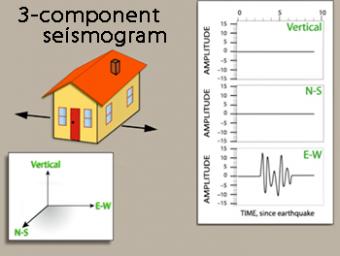How can we model seismic waves in the classroom?
Roger Groom, science teacher at Mount Tabor Middle School, demonstrates how a slinky is a good analogy for P & S seismic waves. He also points out where the model fails to fully mimic seismic-wave behavior. Slinkies prove to be a good tool for modeling the behavior of compressional P waves and shearing S waves. We recommend reading about the behavior of seismic waves and watching the variety of animations linked to this animation to understand how they travel, and how the P, S, and surface waves differ from each other.
Discovery

Each station on the interactive map recorded an earthquake with a characteristic seismogram. Roll over the stations to see the epicenter triangulated. Touch buttons to watch movie of seismic waves, or touch "Walk-run" button to see wave travel can be demonstrated with a class.

Video lecture on wave propagation and speeds of three fundamental kinds of seismic waves.



Video lecture on wave propagation and speeds of three fundamental kinds of seismic waves.

Seismic waves travel through the earth to a single seismic station. Scale and movement of the seismic station are greatly exaggerated to depict the relative motion recorded by the seismogram as P, S, and surface waves arrive.

We use exaggerated motion of a building (seismic station) to show how the ground moves during an earthquake, and why it is important to measure seismic waves using 3 components: vertical, N-S, and E-W. Before showing an actual distant earthquake, we break down the three axes of movement to clarify the 3 seismograms.

A cow and a tree in this narrated cartoon for fun and to emphasize that seismic waves traveling away from an earthquake occur everywhere, not just at seismic stations A, B, C, and D. A person would feel a large earthquake only at station A near the epicenter. Stations B, C, D, and the cow are too far from the earthquake to feel the seismic waves though sensitive equipment records their arrival.

This companion to the animation "Four-Station Seismograph network" shows the arrival of seismic waves through select wave paths through the Earth (P and S waves) and over the surface of the Earth. The movement at distant stations occurs at a microscopic scale. While that doesn't result in noticeable movements of the buildings, the arrivals are recorded on sensitive seismometers.

The shadow zone is the area of the earth from angular distances of 104 to 140 degrees from a given earthquake that does not receive any direct P waves. The different phases show how the initial P wave changes when encountering boundaries in the Earth.

The slinky is an effective tool for the demonstration seismic wave characteristics and wave propagation. Slinkys can be used both individually and in various combinations to demonstration different concepts.

Remember the “stadium wave,” when one person stands and raises his hands in the air and the motion is translated completely around the arena? This simple kinesthetic demonstration uses a similar principal by sending seismic waves through a line of people to illustrate the difference between P waves and S waves propogating through various materials. Lined up shoulder-to-shoulder, students to "become" the material that P and S waves travel through so that once "performed," the principles of seismic waves will not be easily forgotten.